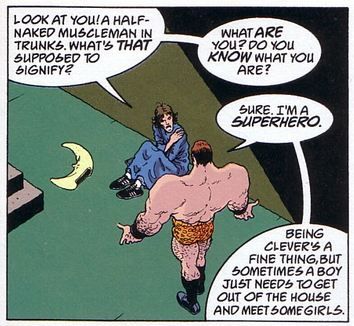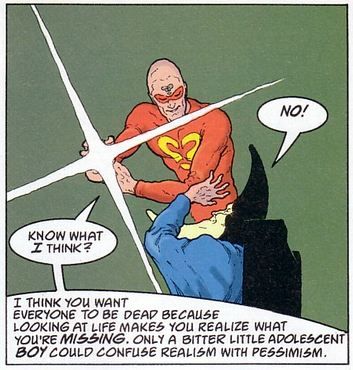I wrote this on a whim and a dare back in 2007, and just recently rediscovered it on my hard drive. I got a kick out of it, and it's not like DC's ever going to publish something like this (Dear DC: If you're ever going to publish something like this, click on "Contact Us"), so I figured I'd share it with our readers. "Gamble a stamp! I can show you how to be a real man!" Without further adieu, here's...
THE DEATH OF FLEX MENTALLO
DC Comics/Vertigo
Proposal for 4 Issues
Written by Bill Reed
Tagline:
Legends never die. They get canceled.
The Premise:
The original Flex Mentallo mini-series by Grant Morrison and Frank Quitely is considered by some, myself included, as the best comic book ever made. It worked as a love letter to superheroes, analyzing their publication history and cultural impact through a twisting, surreal narrative. It absolutely does not need a sequel. This mini-series is the sequel it doesn’t need.
The Morrison/Quitely series commented on a few eras of comics, from the Golden to the Silver to the Grim-and-Gritty Age and then projected into the future. That future, however, did not come true—and this mini will take the baton and comment on the current state of the superhero industry, from character deaths to cancellations and reboots to the Ultimate line to legacy characters to legal issues and creator’s rights.
Flex Mentallo was about the power (and reality) of fiction and the power (and hope) of the superhero. That’s what this one’s about too, in its way. It’s about superheroes transcending the limitations of reality once again. It’s about the cyclical nature of comics and the need for change.
The Plot:
Much like the first Flex mini, this one has worlds within worlds within worlds. In one plotline, Flex Mentallo is living in the world seen at the end of the first series— the one in which the fictional superheroes came to life and returned to bring hope to the world. When we pick up with the planet, society has developed an alarming sense of ennui and boredom with their heroes. There’s no room for hope, after all, if everything’s perfectly fine. It’s a restless civilization; but here comes Flex’s retconned-in sidekick, Charlie the Boy Bodybuilder, all grown up and with a much darker attitude. He’s become an acolyte of a new villain, one with a miniature Planet Earth for a head, a mysterious entity eating away at the corners of the universe…
In another plot, another world, the older, balder Wally Sage (well, he was an avatar for Grant Morrison, so let’s have the hair missing) is being sued by the estate of Carlton Globe, mirroring the real-life legal battle between the Charles Atlas Estate and DC Comics. Sage finds himself driven to the brink by the proceedings, which seem to become more crazed and horrible every day, and finds himself digging up the grave of Carlton Globe, only to find no body in the casket…
And elsewhere, the sales of the Flex Mentallo comic are sagging, and a new wunderkind, by the name of Blake Reeves, is brought in to revitalize the book. If Wally Sage was Grant Morrison, the creator and original visionary of the property, then I must become a character as well, in the form of Reeves, with a little bit of Bendis and Millar and Meltzer thrown in. His new vision is to kill off Flex Mentallo and then end the series, only to reboot it with a new #1 and a fresh take on the character—much like the Ultimate line. As he puts the story out, it becomes real for Flex Mentallo.
Flex finds himself surrounded by heroes who begin to fight each other and reveal their secret identities to the world and kill their enemies and cry and cry the night away. Charlie takes him on in an epic battle that ends with Flex being reduced to the skinny, weak man he was before he discovered Muscle Mystery—and he shrivels up and dies in a fellow hero’s arms. Wally returns to court. The verdict comes down, and Flex Mentallo is condemned.
Reeves then debuts his new series, with the darker, suaver, leaner, meaner Flex Mentallo, filled with sex and violence and explosions. Something keeps slipping into the book, though, seemingly out of Reeves’ control—a villain with a planet for a head…
Wally Sage returns to his home, dejected, reading through old Flex Mentallo comics, reminiscing about the good times, wondering what’s going to happen… And then he sits, with a notepad, and doodles a new Flex comic. It’s simple, but it’s raw imagination. He finishes, looks up, and finds himself back in the Land of Where-You-Get-Your-Ideas.
Wally calls a meeting with the heads of the Globe family, and begins to talk to them. He tells them that ideas are stronger than laws, stronger than anything—and then, to demonstrate, he pulls out a light bulb, the symbolic representation of the idea. It shines in the light—and then the Globes find themselves transported into a different world, and surrounded by superheroes. He wasn’t Wally Sage at all—he was the Hoaxer, the bald villain from the first Flex mini, who helped transport the heroes to reality. All the heroes take off their masks, or even faces, and they’re all Wally Sage underneath.
The Globes recoil, and snarl, and merge into one massive, frightening figure—a creature with Planet Earth for a head. The heroes team up against him, and then Flex Mentallo—the real Flex Mentallo—returns and flexes the crap out of him. The villain collapses, and his globe-head cracks down the middle. Flex leans over him, pitying the guy, and then the scene zooms down onto the globe-head and into Blake Reeves’ world. He thinks he’s going mad as the comics start talking to him, but then he comes face-to-face with Flex Mentallo, Man of Muscle Mystery.
Flex tells Blake that he grew up reading the Flex comics, but the comics didn’t grow up with him. He tried to take the magic from his childhood and transform it to fit his adult sensibilities, but that it didn’t work. In his hand, Flex holds an old, homemade comic, one that Blake wrote and drew when he was a kid, featuring the “debut” of Flex’s sidekick. Flex explains the true origin of Charlie the Boy Bodybuilder—that he was Blake Reeves all along, the culmination of his childhood desire to insert himself into the narrative. Flex also tells him that maybe it’s time to put the old stories away, that causing them to retread over and over is what was hurting the modern comics. Flex realizes that’s why the world was bored of heroes—because they were of a different era, a different time, and they didn’t realize it was time for something new. “Why do a sequel to something that doesn’t need one?” Flex asks. “Maybe it’s time for something else. A new idea. Think about it.” He vanishes, leaving only Blake Reeves and his word processor.
The old heroes return to the land from whence they came, to the mind of Wally Sage. Flex “dies” again, “sacrificing” himself for the sake of the New. It’s time for the new world to find its new heroes, but if they ever need help—well, the old heroes are always waiting, and who knows? Maybe they’ll be back one day…
The End.


